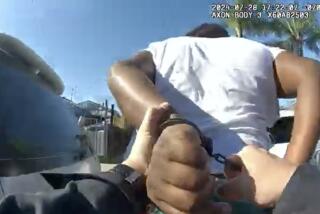Police Look to Unerring Eye of Video
In the aftermath of the videotaped beating of Rodney G. King by Los Angeles police officers, Orange County law enforcement agencies are looking into technology that can put a tamper-proof video camera inside a patrol car to automatically tape an officer’s words and actions.
Several manufacturers of these mobile video cameras say they plan on pitching the high-tech systems to law enforcement agencies throughout the county in the next couple of weeks.
Yet, even before the well-publicized King incident, many agencies in the county expressed interest in the mobile video cameras. At the Garden Grove Police Department, a video camera was installed in a patrol car last December and has been used ever since as a tool for training new officers.
“I like it,” said Garden Grove Police Lt. Ken Adair. “The camera doesn’t lie. You have to interpret it, but it doesn’t lie. It gives us instant feedback.”
He said, however, that the department doesn’t plan to use the video camera for court purposes or to validate or invalidate brutality complaints.
“We bought it just for the purpose of training a new officer out in the field, so they can actually see what they are doing and how they’re doing and review it.” He added that the officers are taped on a voluntary basis and are not required to use it.
Police officials in Anaheim studied the feasibility of a video system several months ago, but ruled it out because of the expense.
“It was cost-prohibitive,” Anaheim Lt. John Cross said, adding the cameras can cost between $4,500 and $8,000 a unit. “When the prices eventually come down, I think it would be a great law enforcement tool.”
Currently, Huntington Beach police and the Orange County Sheriff’s Department are negotiating with several companies to install mobile video units for trial runs, while other agencies are taking a “wait-and-see” stance.
Orange County Sheriff Brad Gates said he supports the use of video technology, which has been installed in the county jails to monitor activities.
“Eventually within the next couple of years you will have a videotape situation of almost everything that goes on of any significance in the field,” Gates said. “That’s going to take a little bit of convincing with police officers in today’s world because there is a negative to these kinds of situations in that they get fearful of Big Brother’s eyes. . . .”
But Robert MacLeod, general manager of the Assn. of Orange County Sheriff’s Deputies, said that most of the rank-and-file officers seem to support the idea.
“I think it will support the fact that police conduct is what it should be. . . . It will vindicate officers in most of the excessive-force complaints. It’s a great deal,” MacLeod said, noting that the association has yet to take an official position on the idea.
An amateur cameraman’s March 3 videotape of the King beating--aired by television stations across the country--has brought a national outcry against police brutality. King was struck more than 50 times by police batons after a car chase in the San Fernando Valley. Four officers await trial on criminal charges in the beating.
Santa Ana Police Chief Paul M. Walters said shortly after the King incident that he was a “strong advocate of technology and video. It only enhances our reputation, our professionalism and it says, hey, if we’re unwilling to be looked at on the video camera that we’re running, there’s really something dreadfully wrong about our system.”
Like other departments in the county, Walters said his agency often takes hand-held cameras to crime scenes, or to situations where they think there might be confrontations, such as at anti-abortion rallies.
Although the technology to install video cameras inside patrol cars has been around for several years, several manufacturers report a dramatic increase of interest in their products after the King beating.
Last week, the Los Angeles Police Department installed a demonstration model to test the system.
“We were interested in what (they) had to say,” said Police Cmdr. Larry Fetters, who will supervise the test in Los Angeles. “The camera would provide documentation of what is happening. Clearly, it would document the behavior of the officer.”
Dave Phillips, marketing director of the CrimTech Corp. of Auburn Hills, Mich., the firm that developed the camera system used by the LAPD, said, “It’s one of the few pieces of equipment that’s liked by both the police and the ACLU.”
The American Civil Liberties Union has been one of the leading voices in the continuing protest over the King beating.
CrimTech’s unit, which goes for $5,500, has a wide-angle lens that provides a broad view through the windshield and can include both a suspect’s vehicle and people standing on either side of it. While it cannot be removed from the patrol car, the camera can be rotated to provide a view in any direction. The officer wears a cordless microphone. His conversations can be picked up a considerable distance from the car, Phillips said.
Other companies manufacture similar types of cameras. Some models have recording units that are kept in the trunk of the car inside special crash-proof and bulletproof boxes. Most can be activated manually by an officer, or automatically as the officer turns on the car’s red lights and siren. The time, date and officers’ names are recorded on tapes that can’t be erased. Advanced models have rotating cameras to follow the officers.
Times staff writer Eric Malnic contributed to this report.
More to Read
Sign up for Essential California
The most important California stories and recommendations in your inbox every morning.
You may occasionally receive promotional content from the Los Angeles Times.









